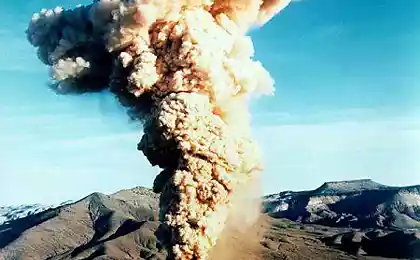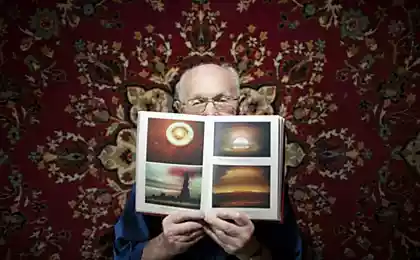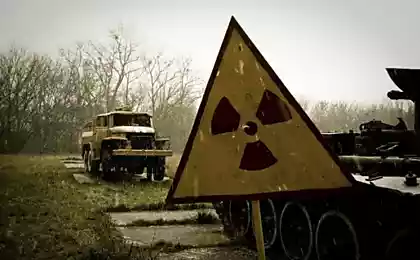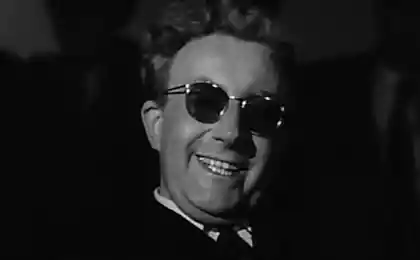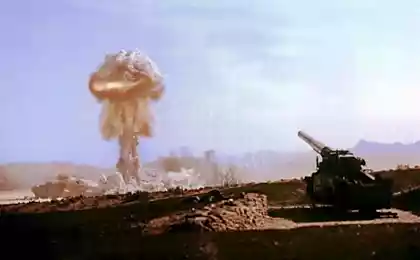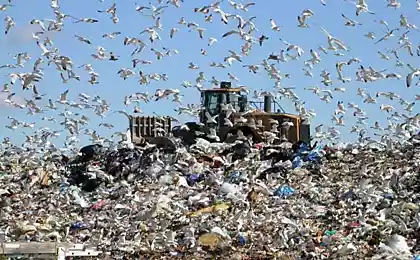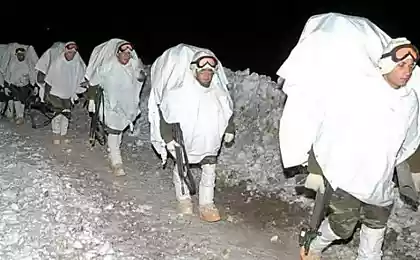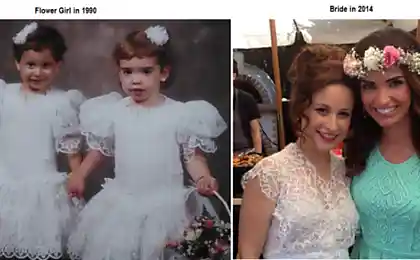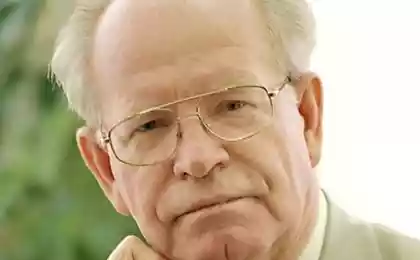2159
Semipalatinsk nuclear test site 20 years later (50 photos)
Not so long ago Kazakhstan celebrated the 20th anniversary of the closure of the Semipalatinsk nuclear test site. Two decades. It seems to be quite a short time, but in that time a whole generation that knows about the barbarian weapon and its testing only from the stories of their parents. And even more, this young generation is difficult to understand why a huge part of the territory of their own country is actually lost forever. Meanwhile, for 20 years the landfill life of its own. And as it turns out, the cessation of nuclear testing and the hydrogen bomb, does not mean that destructive processes in the environment have stopped. The phenomenon of Kazakhstani nuclear science in a special photo essay of Gregory Bedenko
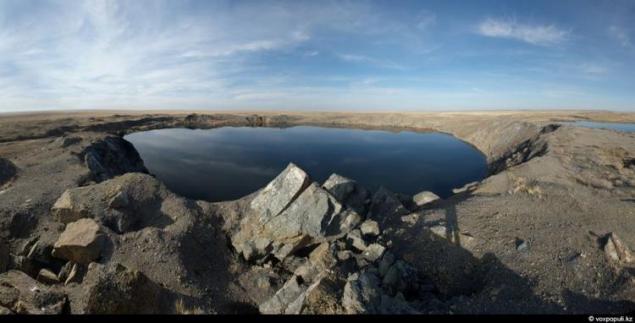
1. The main attraction of the former landfill - "atomic & quot; Lake, which is located on the test site "Balapan". It was formed as a result of the explosion of thermonuclear warhead capacity of 140 kilotonnes in 1965. The diameter of the lake is 500 meters depth from the surface to the bottom 80 meters. In a similar way the Soviet strategists planned to build reservoirs in arid regions of the Soviet Union
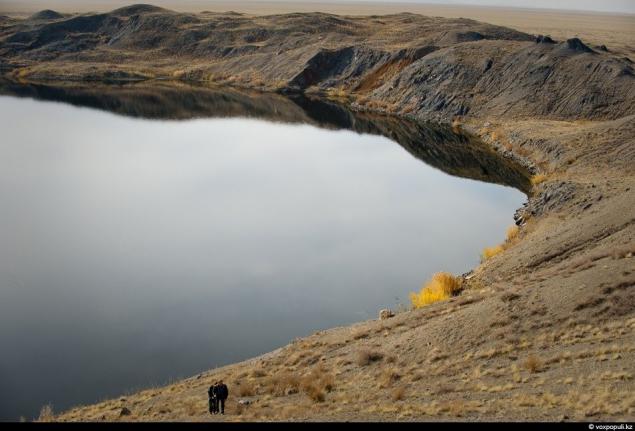
2. Experts IRSE (Institute of Radiation Safety and Ecology of the National Nuclear Center of Kazakhstan) said that the charge was "clean" and therefore the spread of radioactive isotopes on the site is minimal. It is curious that the water in the "atomic & quot; Lake is clean, and there is even the fish is. However, the edges of the pond "Radiation at" so much so that their radiation level is actually equal to the radioactive waste. At this point, the dosimeter shows 1 microsieverts per hour, 114 times more than the norm
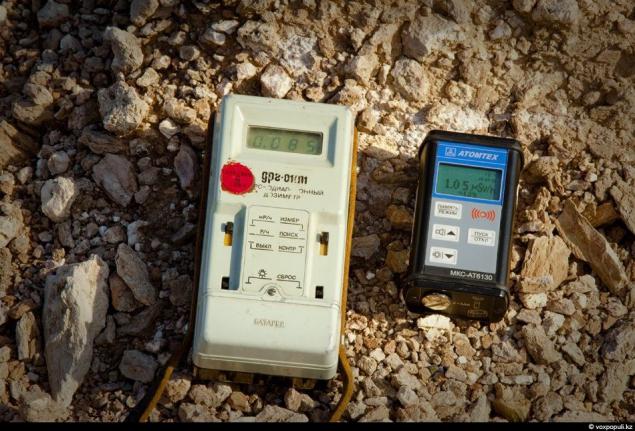
3. An interesting fact about the "atomic" lake: detonation of a thermonuclear device with a capacity of 140 kilotons equivalent while undermining 2 thousand wagons with TNT

4. At the time of the explosion crater washed soil, and some pieces of clay neofitovoy soared a mile, and then fell by about the same distance from the explosion. "Radiation at" they are very
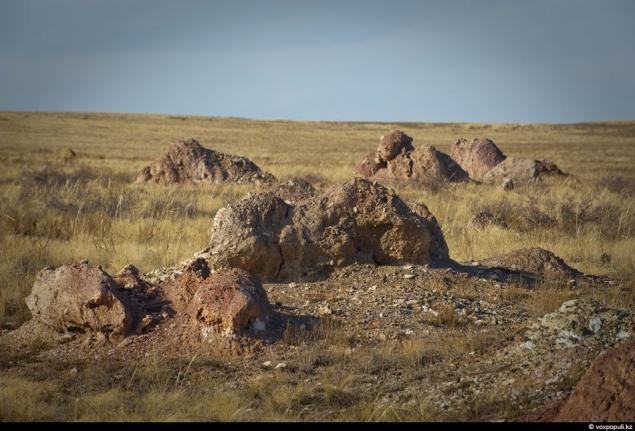
5. This glassy mass, according to experts, was in the vicinity of the thermonuclear charge. A lot of pressure and temperature turned into a kind of granite volcanic pumice
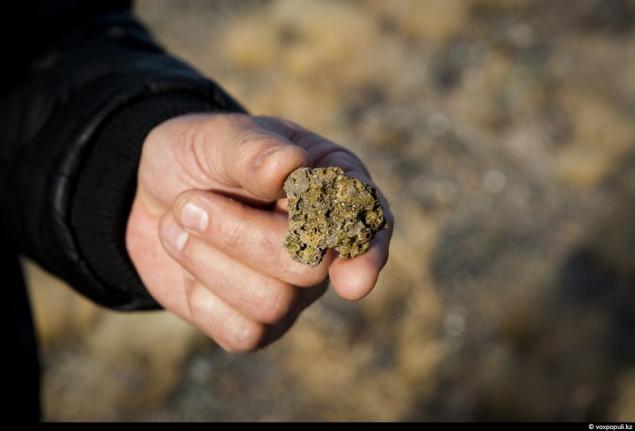
6. Sergey Subbotin. On the range it is called - the master of the "atomic" lake. He is the head of the laboratory of geoinformation technologies, and constantly looks for the object. By the way, Sergey Borisovich at one time provided geological support of underground tests. He is one of those professionals who are directly creating Soviet nuclear shield. Well, even this nice man very similar to Vladimir Vysotsky, even the tone of voice the same
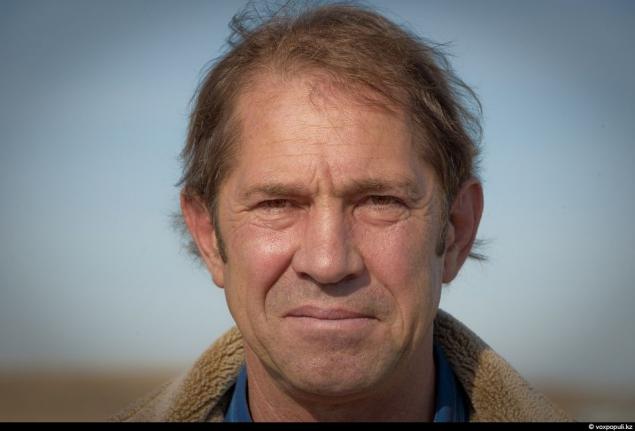
7. River Chagan.
- There have found very high concentrations of tritium (a radioactive isotope of hydrogen), - says Subbotin. - They reach about 700 killobekkreley per liter. That is, it is almost 100 times the standard values for drinking water. Pollution continues somewhere in the interval of 10 kilometers from the borders of the polygon. And part of that is contaminated with tritium, plan to still be included in the composition of the landfill

8. Which is amazing, close to the lake, about two kilometers inhabited. Bred livestock, drinking water from contaminated rivers. Local authorities look the other way. The woman flatly refused to talk to journalists
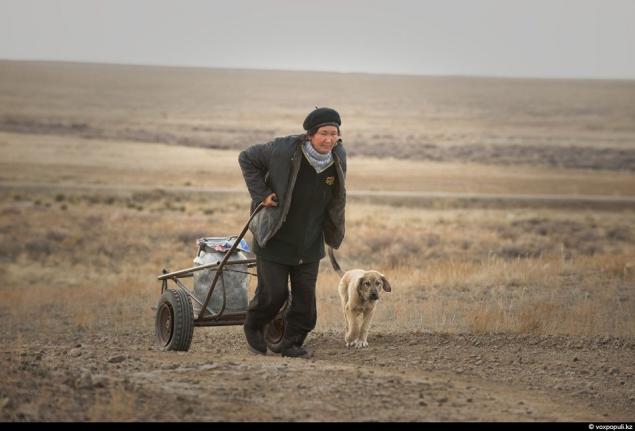
9. And this is the very economy. Apparently, there is not even electricity
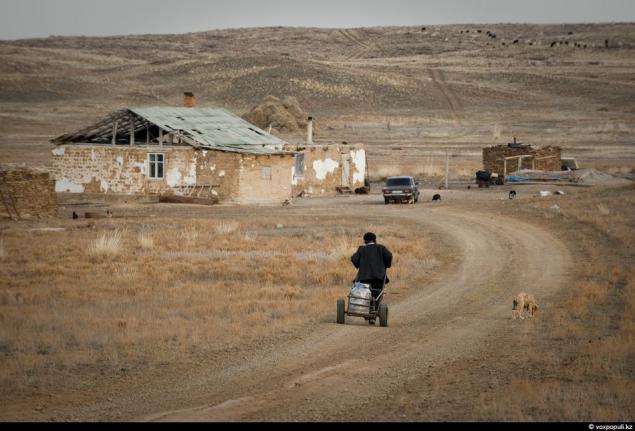
10. Nuclear horses

11. In general, what is most striking at the site - a stormy economic activity. And, in the most "dirty" areas. It is very difficult to imagine something like that somewhere in Nevada or in Lop Nor region

12. However, horses are smart. When they eat grass, rip only the upper part of it, is not grabbing land with radionuclides. Therefore, the mare, as they say in IRSE, at the site clean
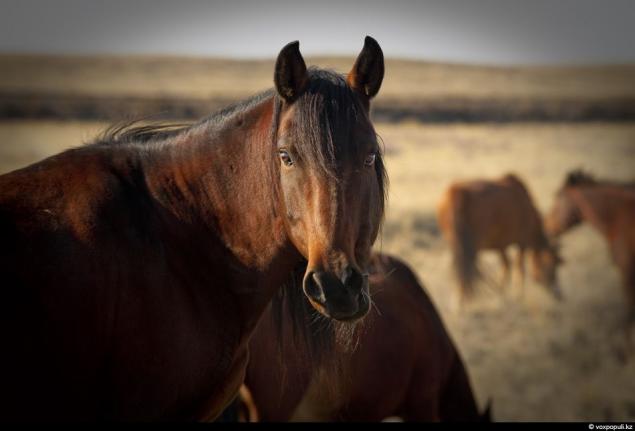
13. "tablet" with academic staff IRSE rises on the shore of the "atomic & quot; lake. Before the explosion there was absolutely flat steppe
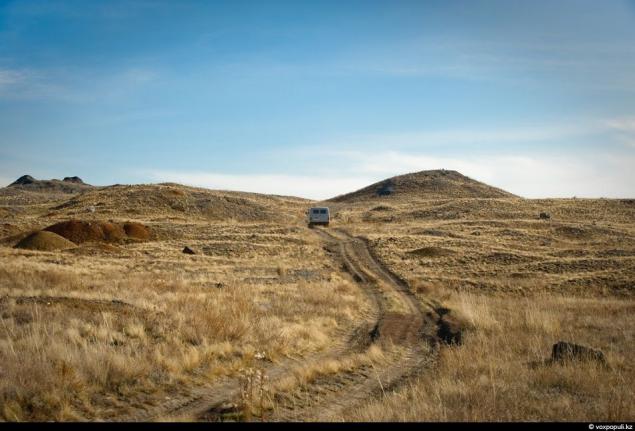
14. Drawdown land and as a result of an underground nuclear explosion. The so-called "fighting well"

15. Watch these objects need to constantly. As a result of neutron activation of coal seams underground occur some strange processes. Subbotin told me that they had a case, when the well exploded 15 years after the tests. From the ground broke a pillar of fire, and the earth in this place subsided within a radius of 100 meters.

16. fox skull found near the well, was spotless

17. Boss Battle wells - a wild dog. Sat and watched with great curiosity for shooting. But when I tried to come closer to him, began to growl, and then ran a few meters

18. The former center of the Semipalatinsk nuclear test site - the city of Kurchatov, the sample of 2011 resembles the scenery for a computer game, such as STALKER "Call of Pripyat"

19. It is the most beautiful ruins that I have ever seen
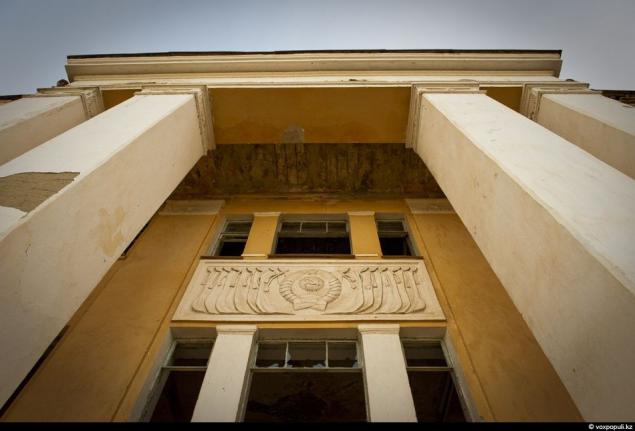
20. So far, half of this amazing village resembles a ghost town
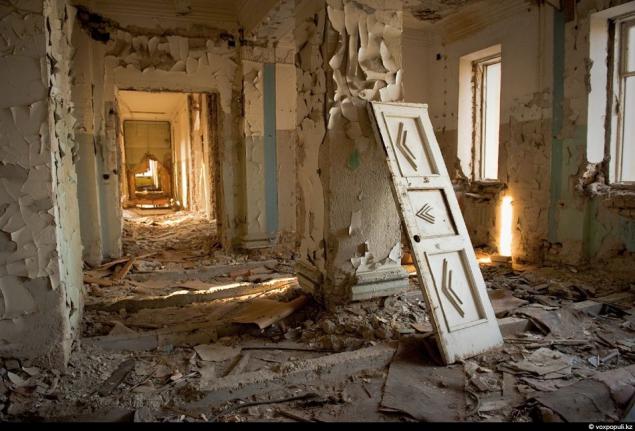
21. Ruins amazing live ...
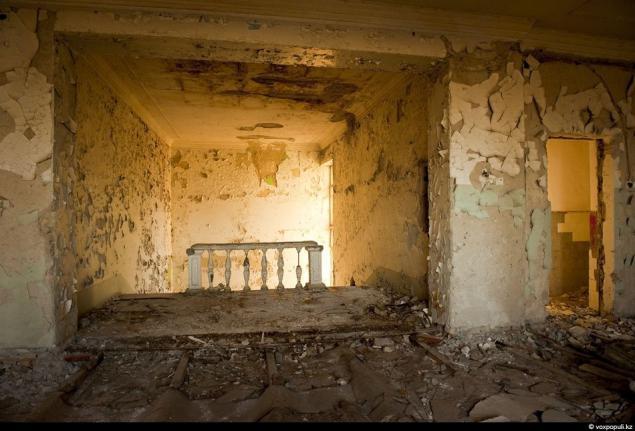
22.

23
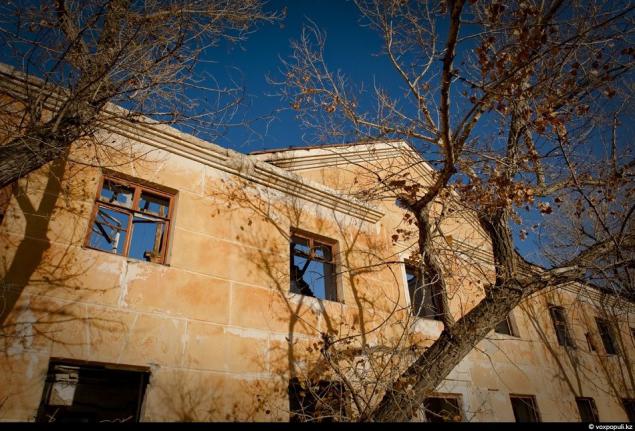
24. The legacy of the war our scientists got unique nuclear reactors. This building "research graphite reactor" (IGR). It was designed by Igor Kurchatov himself even to identify critical loads for such installations
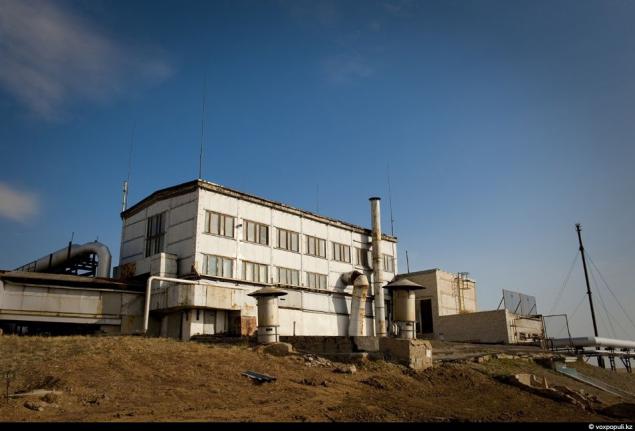
25. Today, the reactor experiments are aimed to simulate the behavior of different materials in severe accidents at nuclear power plants, such as Chernobyl or Fukusismy

26. The experiments were carried out under the order of the Japanese Atomic Energy Agency

27. Head and chief engineer Valery Gaydaychuk

28. The experts are ready to probe materials that will be subjected to a powerful neutron burst inside the reactor. What will happen to these materials - the subject of study
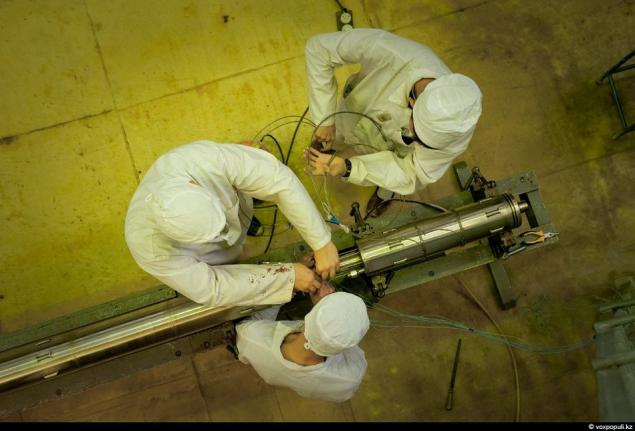
29. And this is how the outside looks like underground structure, which is another reactor - IVG-1 M (Research-high temperature gas reactor)

30. In the special underground bunker corridor leads to it, almost a kilometer long
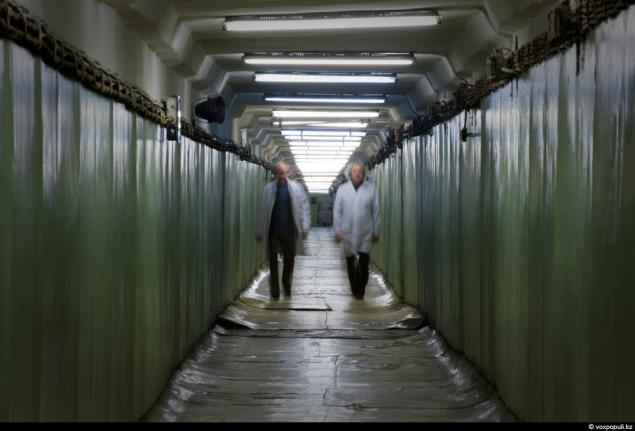
31. The reactor is a prototype of a nuclear rocket engine. He heats hydrogen to ultrahigh temperatures and creates a jet thrust. On this engine during Khrushchev wanted to fly to Mars
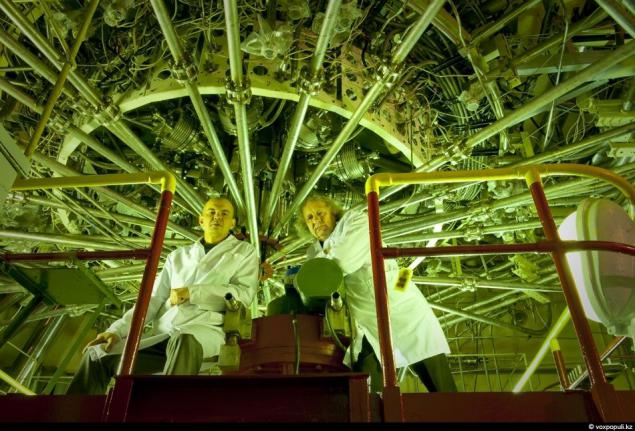
32. - It was even created fuel for nuclear rocket engine, - says head of reactor complex "Baikal-1" Alexander Kolbaenkov. - It meets the parameters that were laid on the technical task - is the temperature, pressure, resource and specific impulse of 925 seconds. It's all been received. And, in principle, if the work is not stopped, we would probably have come to the test series engine, which could be put into orbit and there already run

33. Kolbaenkov been working here for almost 40 years
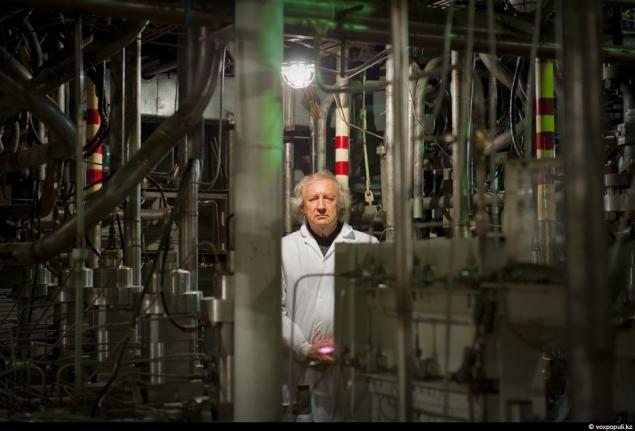
34. Storage of Spent Nuclear Fuel (DKHYAT) on the subject "Baikal-1". Here is the fuel stopped Aktau BN-350 reactor, which operated at the MAEC. Fuel is uranium-235 and plutonium -239 ...
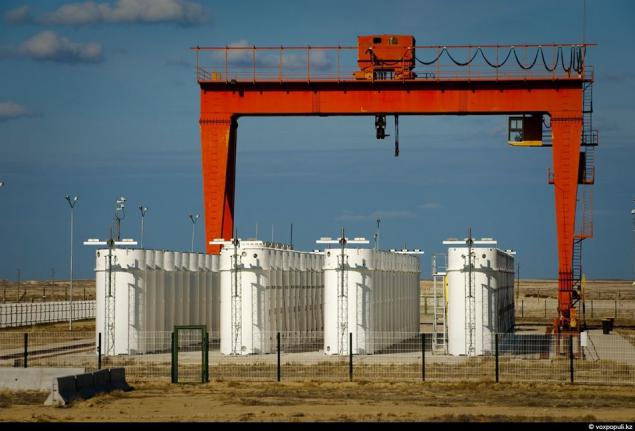
35. Another "attraction" landfill. In this place blew up the first Soviet atomic bomb in 1949
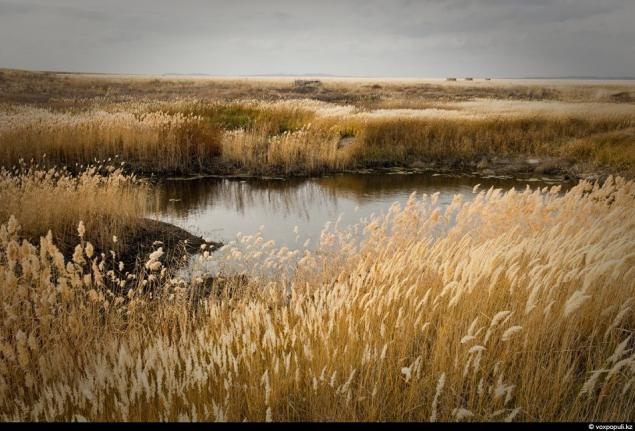
36. This sinister construction is called "goose". With the help of such concrete structures measured shock wave of a nuclear explosion

37. Measurement of radiation. This place was so huge temperature and pressure that the concrete "drip", having absorbed radionuclides

38. The first Soviet atomic bombs were "dirty", so the "experimental field" all contaminated with plutonium. You can only walk in a respirator

39. In these facilities are instrumentation
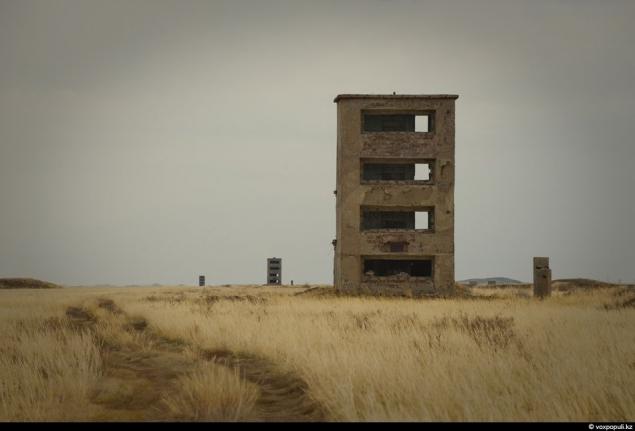
40. In these modules in the "experimental field" live experts IRSE. What is the danger of living here? The fact that this object is the beginning of the Soviet nuclear weapons program. On the range a lot of different areas, but all begin with "experimental field". The first Soviet nuclear and hydrogen explosive devices were very "dirty". They worked only 30-40% of the mass of the charge. The remainder of the charge, and it's basically an extremely dangerous for all living isotopes of plutonium, sprayed in the environment. Thus, the "experimental field", almost completely infected them. An area of 300 square kilometers is considered lost - the half-life of plutonium-239, about 20 thousand years. Nanoparticles plutonium can breathe with the dust, will go on if the infected "spots" or when the wind rises. Remove plutonium from the body is impossible - even if one particle got inside, she just vyzhget all tissues around them. Therefore, experts IRSE who live on the "experimental field" are risking their health. This is a kind of feat in the name of science. Without exaggeration

41. It employs experimental livestock farm
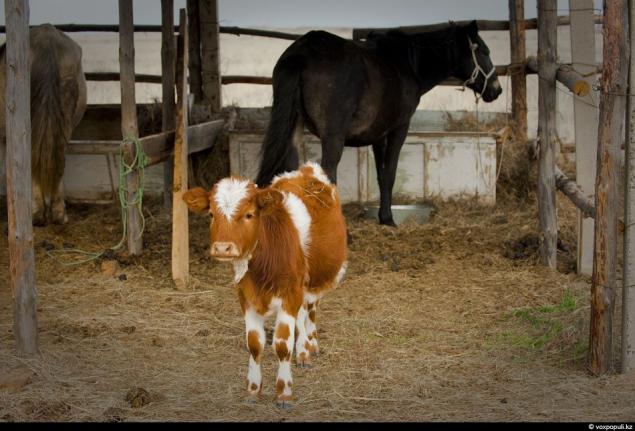
42. Lionheart Symbat Baigazov specialist institute, looks after the animals
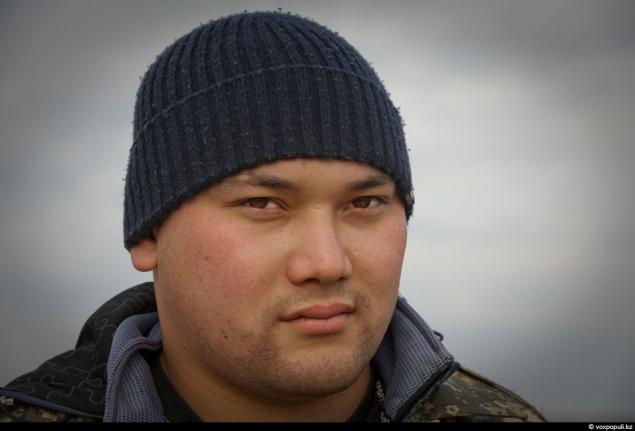
43. Symbat and his ward - mare Anka
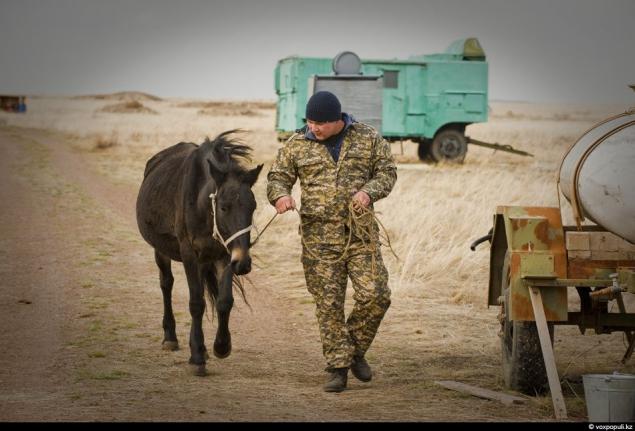
44. The experiment is as follows: some animals are fed contaminated feed, give other contaminated water. Others graze in contaminated areas. The purpose of the experiment - to identify what dose received local people eating "dirty" food

45. Symbat and calf Brawler. At 200 meters from this place - plutonium crater from hydrogen bomb
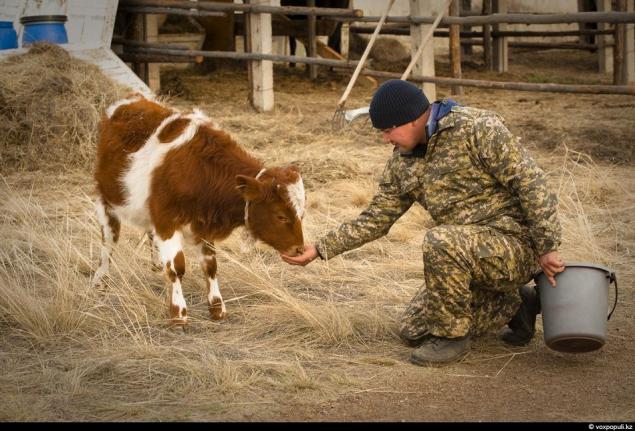
46. The brainchild of Kazakhstan's independence - Tokamak - a prototype fusion reactor of the future. Created to study the properties of materials
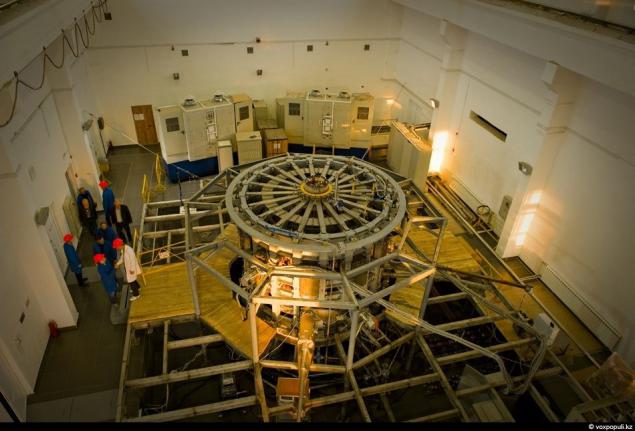
47. Gennady Shapovalov - Researcher, Institute of Atomic Energy and the main tokamak.
- Actually, this is planned tokamaks sufficiently high range of the study. This new plant, which has specific physical parameters, which in similar facilities in the world is
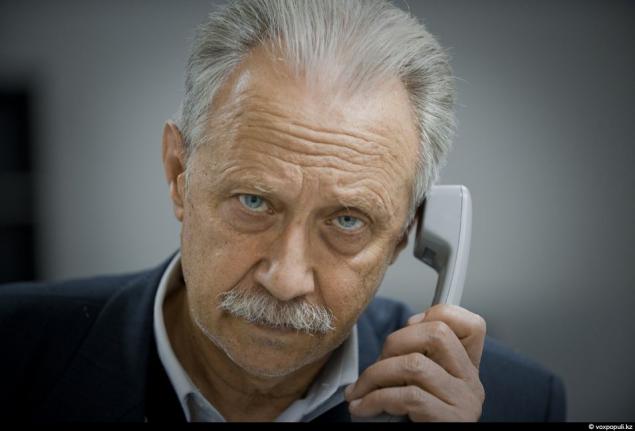
48. The molten concrete on the "experimental field».
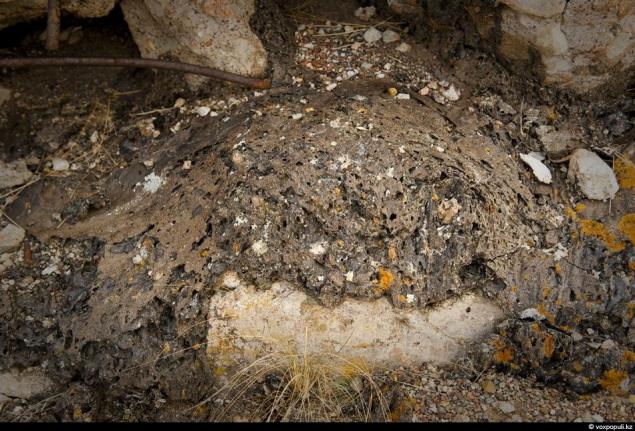
49. Today we can safely say that the development of science in our country related to nuclear energy - in Eurasia completely unprecedented and even paradoxical fact. Everything had to happen exactly the opposite: when the test site at Semipalatinsk left the last war, Kurchatov had to share the fate of many post-Soviet ghost town. And that seems to be easier - wrap the infected area with barbed wire and forget about them forever. But the reality is actually much more difficult - the consequences of nuclear weapon tests were, are and will remain part of our lives
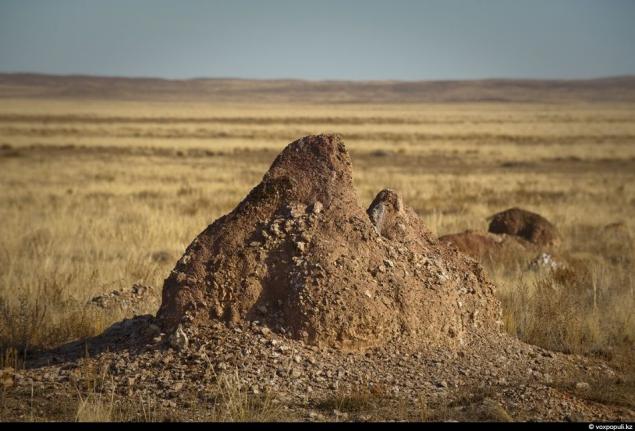
Source

1. The main attraction of the former landfill - "atomic & quot; Lake, which is located on the test site "Balapan". It was formed as a result of the explosion of thermonuclear warhead capacity of 140 kilotonnes in 1965. The diameter of the lake is 500 meters depth from the surface to the bottom 80 meters. In a similar way the Soviet strategists planned to build reservoirs in arid regions of the Soviet Union

2. Experts IRSE (Institute of Radiation Safety and Ecology of the National Nuclear Center of Kazakhstan) said that the charge was "clean" and therefore the spread of radioactive isotopes on the site is minimal. It is curious that the water in the "atomic & quot; Lake is clean, and there is even the fish is. However, the edges of the pond "Radiation at" so much so that their radiation level is actually equal to the radioactive waste. At this point, the dosimeter shows 1 microsieverts per hour, 114 times more than the norm

3. An interesting fact about the "atomic" lake: detonation of a thermonuclear device with a capacity of 140 kilotons equivalent while undermining 2 thousand wagons with TNT

4. At the time of the explosion crater washed soil, and some pieces of clay neofitovoy soared a mile, and then fell by about the same distance from the explosion. "Radiation at" they are very

5. This glassy mass, according to experts, was in the vicinity of the thermonuclear charge. A lot of pressure and temperature turned into a kind of granite volcanic pumice

6. Sergey Subbotin. On the range it is called - the master of the "atomic" lake. He is the head of the laboratory of geoinformation technologies, and constantly looks for the object. By the way, Sergey Borisovich at one time provided geological support of underground tests. He is one of those professionals who are directly creating Soviet nuclear shield. Well, even this nice man very similar to Vladimir Vysotsky, even the tone of voice the same

7. River Chagan.
- There have found very high concentrations of tritium (a radioactive isotope of hydrogen), - says Subbotin. - They reach about 700 killobekkreley per liter. That is, it is almost 100 times the standard values for drinking water. Pollution continues somewhere in the interval of 10 kilometers from the borders of the polygon. And part of that is contaminated with tritium, plan to still be included in the composition of the landfill

8. Which is amazing, close to the lake, about two kilometers inhabited. Bred livestock, drinking water from contaminated rivers. Local authorities look the other way. The woman flatly refused to talk to journalists

9. And this is the very economy. Apparently, there is not even electricity

10. Nuclear horses

11. In general, what is most striking at the site - a stormy economic activity. And, in the most "dirty" areas. It is very difficult to imagine something like that somewhere in Nevada or in Lop Nor region

12. However, horses are smart. When they eat grass, rip only the upper part of it, is not grabbing land with radionuclides. Therefore, the mare, as they say in IRSE, at the site clean

13. "tablet" with academic staff IRSE rises on the shore of the "atomic & quot; lake. Before the explosion there was absolutely flat steppe

14. Drawdown land and as a result of an underground nuclear explosion. The so-called "fighting well"

15. Watch these objects need to constantly. As a result of neutron activation of coal seams underground occur some strange processes. Subbotin told me that they had a case, when the well exploded 15 years after the tests. From the ground broke a pillar of fire, and the earth in this place subsided within a radius of 100 meters.

16. fox skull found near the well, was spotless

17. Boss Battle wells - a wild dog. Sat and watched with great curiosity for shooting. But when I tried to come closer to him, began to growl, and then ran a few meters

18. The former center of the Semipalatinsk nuclear test site - the city of Kurchatov, the sample of 2011 resembles the scenery for a computer game, such as STALKER "Call of Pripyat"

19. It is the most beautiful ruins that I have ever seen

20. So far, half of this amazing village resembles a ghost town

21. Ruins amazing live ...

22.

23

24. The legacy of the war our scientists got unique nuclear reactors. This building "research graphite reactor" (IGR). It was designed by Igor Kurchatov himself even to identify critical loads for such installations

25. Today, the reactor experiments are aimed to simulate the behavior of different materials in severe accidents at nuclear power plants, such as Chernobyl or Fukusismy

26. The experiments were carried out under the order of the Japanese Atomic Energy Agency

27. Head and chief engineer Valery Gaydaychuk

28. The experts are ready to probe materials that will be subjected to a powerful neutron burst inside the reactor. What will happen to these materials - the subject of study

29. And this is how the outside looks like underground structure, which is another reactor - IVG-1 M (Research-high temperature gas reactor)

30. In the special underground bunker corridor leads to it, almost a kilometer long

31. The reactor is a prototype of a nuclear rocket engine. He heats hydrogen to ultrahigh temperatures and creates a jet thrust. On this engine during Khrushchev wanted to fly to Mars

32. - It was even created fuel for nuclear rocket engine, - says head of reactor complex "Baikal-1" Alexander Kolbaenkov. - It meets the parameters that were laid on the technical task - is the temperature, pressure, resource and specific impulse of 925 seconds. It's all been received. And, in principle, if the work is not stopped, we would probably have come to the test series engine, which could be put into orbit and there already run

33. Kolbaenkov been working here for almost 40 years

34. Storage of Spent Nuclear Fuel (DKHYAT) on the subject "Baikal-1". Here is the fuel stopped Aktau BN-350 reactor, which operated at the MAEC. Fuel is uranium-235 and plutonium -239 ...

35. Another "attraction" landfill. In this place blew up the first Soviet atomic bomb in 1949

36. This sinister construction is called "goose". With the help of such concrete structures measured shock wave of a nuclear explosion

37. Measurement of radiation. This place was so huge temperature and pressure that the concrete "drip", having absorbed radionuclides

38. The first Soviet atomic bombs were "dirty", so the "experimental field" all contaminated with plutonium. You can only walk in a respirator

39. In these facilities are instrumentation

40. In these modules in the "experimental field" live experts IRSE. What is the danger of living here? The fact that this object is the beginning of the Soviet nuclear weapons program. On the range a lot of different areas, but all begin with "experimental field". The first Soviet nuclear and hydrogen explosive devices were very "dirty". They worked only 30-40% of the mass of the charge. The remainder of the charge, and it's basically an extremely dangerous for all living isotopes of plutonium, sprayed in the environment. Thus, the "experimental field", almost completely infected them. An area of 300 square kilometers is considered lost - the half-life of plutonium-239, about 20 thousand years. Nanoparticles plutonium can breathe with the dust, will go on if the infected "spots" or when the wind rises. Remove plutonium from the body is impossible - even if one particle got inside, she just vyzhget all tissues around them. Therefore, experts IRSE who live on the "experimental field" are risking their health. This is a kind of feat in the name of science. Without exaggeration

41. It employs experimental livestock farm

42. Lionheart Symbat Baigazov specialist institute, looks after the animals

43. Symbat and his ward - mare Anka

44. The experiment is as follows: some animals are fed contaminated feed, give other contaminated water. Others graze in contaminated areas. The purpose of the experiment - to identify what dose received local people eating "dirty" food

45. Symbat and calf Brawler. At 200 meters from this place - plutonium crater from hydrogen bomb

46. The brainchild of Kazakhstan's independence - Tokamak - a prototype fusion reactor of the future. Created to study the properties of materials

47. Gennady Shapovalov - Researcher, Institute of Atomic Energy and the main tokamak.
- Actually, this is planned tokamaks sufficiently high range of the study. This new plant, which has specific physical parameters, which in similar facilities in the world is

48. The molten concrete on the "experimental field».

49. Today we can safely say that the development of science in our country related to nuclear energy - in Eurasia completely unprecedented and even paradoxical fact. Everything had to happen exactly the opposite: when the test site at Semipalatinsk left the last war, Kurchatov had to share the fate of many post-Soviet ghost town. And that seems to be easier - wrap the infected area with barbed wire and forget about them forever. But the reality is actually much more difficult - the consequences of nuclear weapon tests were, are and will remain part of our lives

Source




